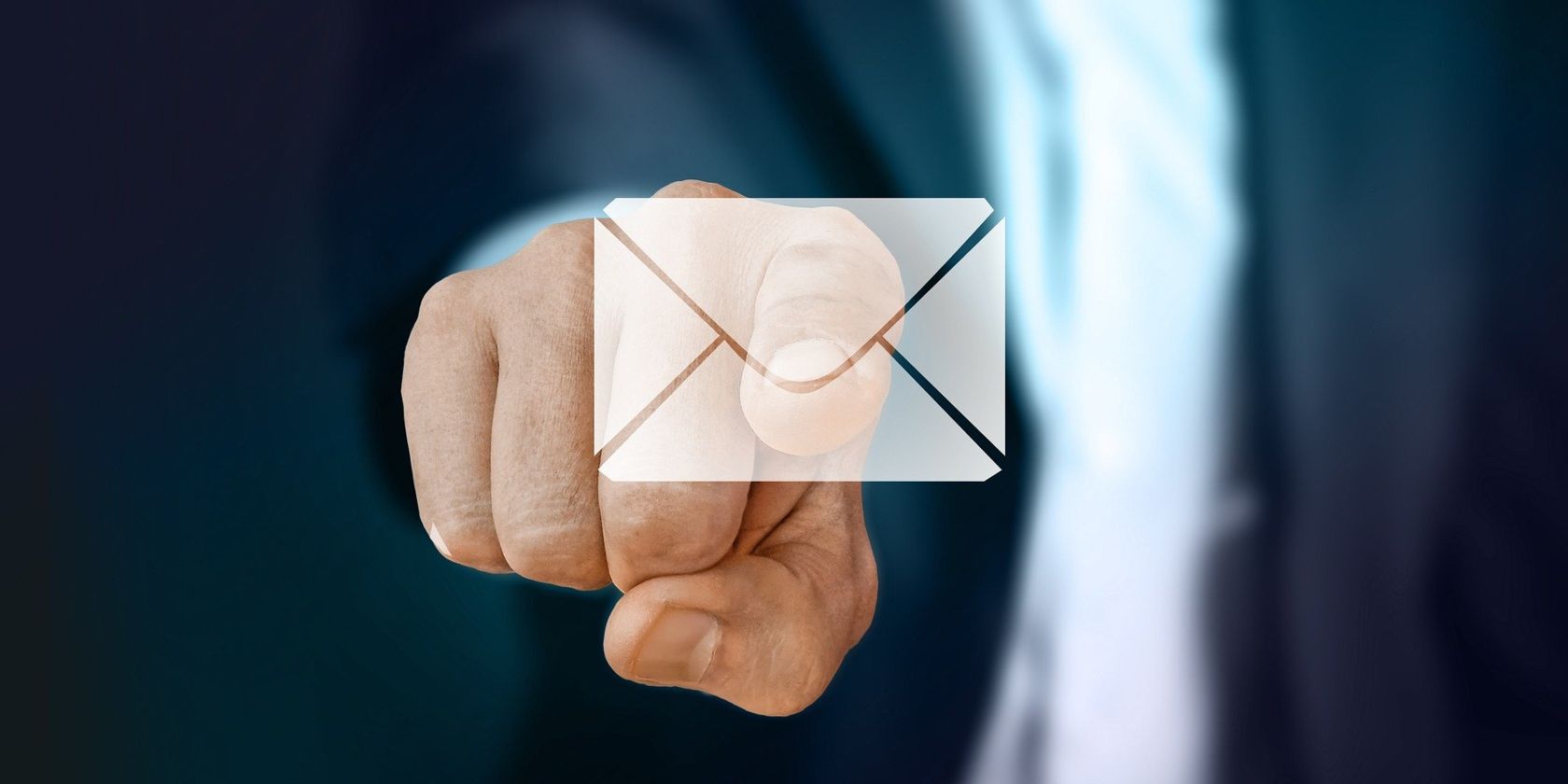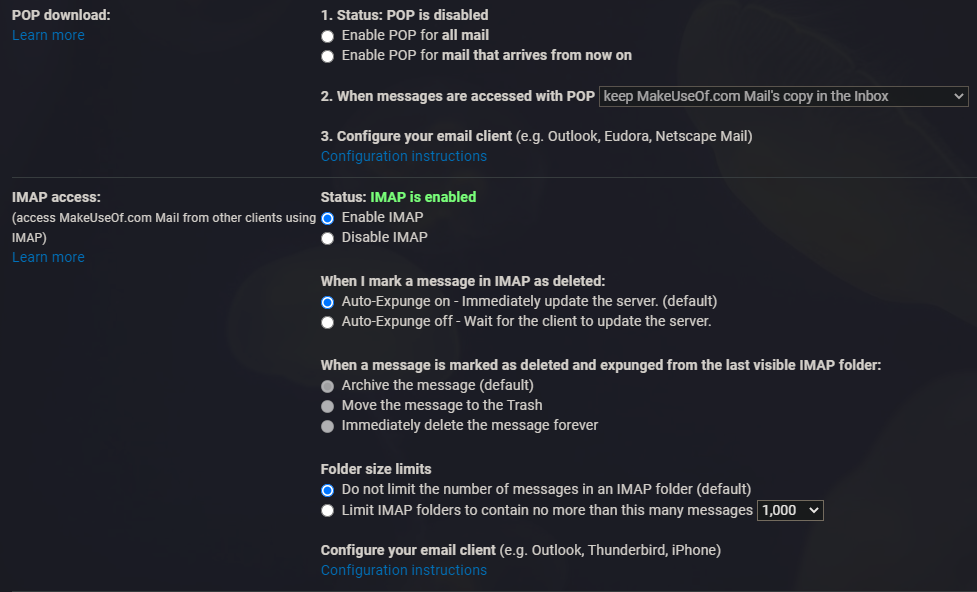Which Email Protocol Allows An Email Client To Download Email Messages To The Local Computer?
When you set upward an email client or app, you lot'll come across the terms Popular and IMAP. Do you know which 1 to choose, and why? If you aren't sure what these terms stand for and how each affects your email account, don't worry.
Below, nosotros explicate how these protocols work, the differences betwixt POP and IMAP, and how to decide which one best fits your needs.
POP vs. IMAP: The Basics
Popular and IMAP are both protocols used for retrieving email from an electronic mail server so you can read messages on your device. They're used when connecting to your electronic mail account from a desktop electronic mail app, like Thunderbird, Outlook, Apple Mail, Spark, or similar. You don't need to worry about these electronic mail protocols when yous employ webmail (such as Gmail.com), considering the service handles it all for you lot.
Pop stands for Mail service Office Protocol, and is the older of the ii. It was created in 1984 as a mode to download emails from a remote server. Two revisions that added some enhancements, called POP2 and POP3, followed in later years. POP3 is all the same the current version of the protocol, though this is oft shortened to merely Pop. While POP4 has been proposed, information technology's been dormant for a long time.
IMAP, or Internet Bulletin Admission Protocol, was designed in 1986. Instead of simply retrieving emails, it was created to allow remote access to emails stored on a remote server. The current version is IMAP4, though most interfaces don't include the number.
The primary departure is that Popular downloads emails from the server for permanent local storage, while IMAP leaves them on the server while caching (temporarily storing) emails locally. In this style, IMAP is effectively a form of cloud storage.
The Workflow Differences Between POP and IMAP
To properly compare POP and IMAP, let's look at a simplified version of how they each work.
The POP Workflow
When using Pop, the email client showtime connects to the electronic mail server. Once information technology's successfully connected, it grabs all the mail on the server. It and then stores this mail locally on your device so you lot can access information technology in your email customer. Finally, information technology deletes the mail in question from the electronic mail server before disconnecting. This means that the messages then only exist on the device you downloaded them to.
Annotation that while POP will delete mail service from the server by default, a lot of Popular setups let you lot to leave copies of your email on the server. This can be useful if you're worried about losing your mail service, but if your mail provider doesn't offer much server space, it tin cause you to run out chop-chop.
How IMAP Works
IMAP works a little differently than POP. After it connects to the email server, information technology fetches any content you lot requested, like all new email or the contents of a specific bulletin. This is cached locally, so you lot can work on your device. In one case yous make changes to your electronic mail, such as deleting messages or sending a new email, the server processes and saves these changes, so disconnects.
IMAP is a little more complex than Pop, but the biggest attribute to remember is that all changes with IMAP happen on the server. You aren't downloading local copies of all your messages; you're using the email customer to manage the email stored on the server. The but data stored on your device (unless you explicitly download something) are cached copies for efficiency.

Pros and Cons of Pop and IMAP
At present that you know how they each piece of work, what are the benefits and drawbacks of using POP or IMAP?
Advantages and Disadvantages of Popular
POP was designed for a simpler time when you just needed to access your electronic mail from one device. In those days, constant internet access also wasn't common, so POP made sense for dial-upward connections where you got online, did what you needed, then disconnected. It thus has the following pros:
- Mail is stored locally, and so it's always accessible even without an internet connexion.
- An internet connection is needed only for sending and receiving mail service. Managing it works fine offline.
- It saves server storage space, since old messages are deleted from the server automatically.
- You accept the pick to go out copy of mail on the server, giving flexibility if needed.
- If you like, information technology'south possible to consolidate multiple email accounts and servers into i inbox.

Popular has some advantages in specific situations, but it's largely outdated today. It's not designed for checking electronic mail from multiple devices, and then you can experience problems even if you leave a copy of e-mail on the server. For instance, if you delete an e-mail on one device, that deletion doesn't sync to the server, so other devices will still have that message. And since each device downloads every message from the server, it's easy to stop up with a bunch of duplicates and not know what you've already dealt with.
Downloading every message from your Pop account can employ up a lot of space on your device, depending on how much mail yous have. A lot of Pop use today is to admission mailboxes provided by your ISP, web hosting visitor, or similar, which tend to endure from extremely limited storage.
Advantages and Disadvantages of IMAP
As mentioned earlier, IMAP was created to allow remote access to emails stored on a remote server. The idea is to allow multiple clients to manage the same inbox, which is in line with how about people utilise email today. So whether you log in from your dwelling house or piece of work computer, you will always see the same emails and binder structure, since they are stored on the server. All changes y'all brand are immediately synced to the server, and then you don't have to worry about disruptive duplicated inboxes.

Equally a event, IMAP has the following advantages:
- Mail is stored on the remote server, and then it's accessible from multiple devices.
- All changes are tracked on the server, preventing duplicate inboxes, sent messages existing on just 1 device, and like issues.
- Faster overview, as only headers are downloaded until content is explicitly requested.
- Postal service is automatically backed upward, as long as the server is managed properly.
- Saves local storage infinite by not requiring your computer to download all letters.
- You accept the choice to shop mail locally if needed.
While an internet connection is needed to admission mail using IMAP, it's still possible to work offline and sync changes when you're dorsum online. The simply major drawback of IMAP, which is also a trouble with POP, is that nigh email providers offer a limited amount of space. Thus, you may demand to make clean out your electronic mail frequently if you have lots of messages in your account.
POP vs. IMAP: What'due south Right for Me?
In almost every case, we recommend IMAP over POP today. At that place's a good chance that y'all'll desire to admission your email from at least two devices, and doing so with Pop is a huge headache. Since every email service worth its salt supports both, there are no compatibility concerns.
Withal, if you're still not sure, below are a few points to help you decide whether to employ IMAP or Pop:
Cull Pop if:
- You lot only access your mail from a single device, and never plan to access it from another.
- You need constant access to all your e-mail.
- Your don't have a consistent connection to the internet.
- You lot have limited server storage.
Cull IMAP if:
- Yous want to access your email from multiple devices.
- You accept a reliable and constant cyberspace connection.
- You want to receive a quick overview of new emails or emails on the server.
- Your local storage space is limited.
- You are worried near bankroll your emails up.
What Most Microsoft Exchange?
While POP and IMAP are supported by every mod email service, y'all've likely seen another entry when setting upwardly mail service: Microsoft Exchange. Also called Exchange ActiveSync, this option uses Microsoft'southward Messaging Application Programming Interface (MAPI) to fetch email and other information and then your mail service client can read it. In improver to electronic mail, MAPI tin sync other data like calendars and contacts.
If you use Outlook on your computer at work, or if your visitor has email powered by Microsoft 365, yous'll use Substitution for your email protocol. It's similar to IMAP in functionality, just is more specific to Microsoft'due south services.
POP and IMAP: Your Post, Delivered
It'due south of import to know how Popular and IMAP work so you lot tin make the right pick for your email needs. Remember that if you use webmail, the service handles all this, so y'all don't have to think about it. Only next time you fix a new electronic mail app on your telephone or figurer, you'll know how both of these protocols handle mail. IMAP is almost always the right choice, unless yous have some specific reason to go with Popular.
There'southward a lot more to learn about how email works, including the security measures built into modern messaging.
About The AuthorSource: https://www.makeuseof.com/tag/pop-vs-imap/
Posted by: bassettexamseaten.blogspot.com



0 Response to "Which Email Protocol Allows An Email Client To Download Email Messages To The Local Computer?"
Post a Comment